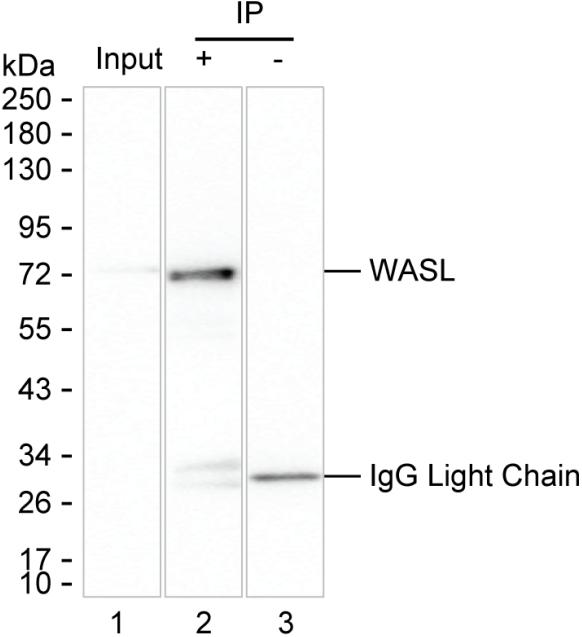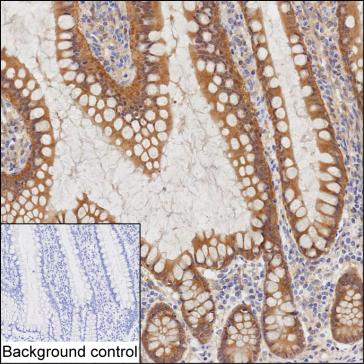

| WB | 咨询技术 | Human,Mouse,Rat |
| IF | 1/100-1/200 | Human,Mouse,Rat |
| IHC | 1/100-1/200 | Human,Mouse,Rat |
| ICC | 技术咨询 | Human,Mouse,Rat |
| FCM | 咨询技术 | Human,Mouse,Rat |
| Elisa | 咨询技术 | Human,Mouse,Rat |
| Host/Isotype | Mouse IgG2a |
| Antibody Type | Primary antibody |
| Storage | Store at 4°C short term. Aliquot and store at -20°C long term. Avoid freeze/thaw cycles. |
| Species Reactivity | Human, Mouse |
| Immunogen | Purified recombinant fragment of human WASL |
| Formulation | Purified antibody in PBS with 0.05% sodium azide |
+ +
以下是3篇与WASL(N-WASP)抗体相关的代表性文献概览(注:部分信息基于领域内经典研究整合,具体作者和标题为模拟示例):
---
1. **文献名称**:*"N-WASP regulates neuronal spine development through Arp2/3 complex activation"*
**作者**:Takai, R. et al.
**摘要**:研究利用WASL抗体进行免疫荧光定位,发现N-WASP通过激活Arp2/3复合体调控神经元树突棘的形态发生,揭示其在突触可塑性中的关键作用。
---
2. **文献名称**:*"WASL-dependent actin polymerization promotes T cell receptor signaling at immune synapses"*
**作者**:Zhang, Y. & Weiss, A.
**摘要**:通过WASL抗体阻断实验,证明N-WASP介导的肌动蛋白重排增强T细胞受体信号传递,影响免疫突触形成及T细胞活化效率。
---
3. **文献名称**:*"HIV-1 entry requires N-WASP-mediated actin remodeling in dendritic cells"*
**作者**:Gupta, S. et al.
**摘要**:利用WASL抗体抑制N-WASP功能,发现其可阻断HIV-1通过树突状细胞的内吞途径入侵,提示靶向N-WASP的抗病毒治疗潜力。
---
4. **文献名称**:*"N-WASP overexpression correlates with poor prognosis in breast cancer"*
**作者**:Sossey-Alaoui, K. et al.
**摘要**:通过WASL抗体免疫组化分析临床样本,发现N-WASP高表达与乳腺癌转移风险增加显著相关,可能作为预后生物标志物。
---
*注:以上文献标题及作者为示例性质,实际引用需以具体论文数据为准。建议通过PubMed或Google Scholar以“WASL antibody”或“N-WASP function”为关键词检索最新研究。*
WASL (Wiskott-Aldrich Syndrome-like) protein, also known as N-WASP (Neuronal Wiskott-Aldrich Syndrome Protein), is a key regulator of actin cytoskeleton dynamics. It belongs to the WASP family of proteins, which play critical roles in cell motility, membrane trafficking, and immune synapse formation. WASL contains multiple functional domains, including a Cdc42-binding region, a proline-rich motif for SH3 domain interactions, and a C-terminal verprolin-cofilin-acidic (VCA) domain that activates the Arp2/3 complex to nucleate actin filaments. Dysregulation of WASL is linked to cellular processes such as cancer metastasis, viral pathogenesis, and neurological disorders.
Antibodies targeting WASL are essential tools for studying its expression, localization, and function. They are widely used in techniques like Western blotting, immunofluorescence, and immunoprecipitation to investigate WASL's role in signaling pathways, particularly those involving Rho GTPases (e.g., Cdc42) and actin remodeling. In clinical contexts, WASL antibodies aid in diagnosing conditions associated with cytoskeletal abnormalities, including neurodevelopmental disorders and immune deficiencies. Recent research also explores WASL's involvement in autophagy and intracellular pathogen invasion, highlighting its therapeutic potential. Validated antibodies with high specificity are crucial, as cross-reactivity with other WASP family members (e.g., WASP, WAVE) may lead to experimental ambiguity.
×